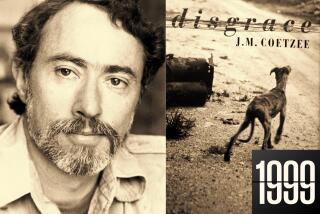The Novelist and the Murderer : CROSSED OVER: A Murder, A Memoir <i> By Beverly Lowry</i> , <i> (Alfred A. Knopf: $22; 247 pp.)</i>
In the spring of 1986, Texas novelist Beverly Lowry happened upon a photograph that upended her life. The photograph, printed in the Houston Chronicle, was of Karla Faye Tucker, a 26-year-old Death Row inmate in the Texas prison system. Tucker had received her death sentence in 1983, a few months after being arrested for murdering two people with a pickax. One of the victims was a man she knew and hated; the other was a woman she had never met but who happened to be in the wrong place at the wrong time.
The article accompanying the photo discussed how Tucker had become a changed woman behind bars: remorseful, penitent, born again. Like most Texans, Lowry remembered reading about the Houston case. In particular, she recalled the choice of weapon, and how Tucker had told someone that butchering her victims had sexually excited her. It puzzled the novelist that someone so evil could now seem so angelic. Lowry stared long and hard at the wide-eyed, sweetly smiling girl in the photograph. Eventually the novelist arranged to meet the inmate.
For years thereafter, Lowry traveled monthly to the Mountain View Unit of the Texas Department of Corrections and spent whole afternoons talking with Tucker. Their shared story forms the basis of “Crossed Over: A Murder, A Memoir,” Lowry’s first nonfiction work.
The book is both agonizing and beautiful, and a tremendous literary achievement. In it, Lowry tells two stories. First is the saga of Tucker, born into a kind of “Blue Velvet” underworld. She sold her body, did every drug there was to do and prided herself on her fistfighting abilities.
Lowry portrays Tucker as a girl whose appetite for cheap thrills led, perhaps inevitably, to the early morning of June 13, 1983, when Tucker and two male friends drove to the apartment of Jerry Dean with the intent of stealing motorcycle parts. Though murder was not on their minds, nothing in their collective moral framework foreclosed the possibility of taking a human life.
When Tucker and one of her companions, Danny Garrett, entered Dean’s apartment and saw him lying on his bed, they reacted like wildcats at the sight of a wounded rabbit: Garrett attacked Dean with a hammer; Tucker finished the job with a pickax that happened to be lying to hand. When she discovered that someone else was in the room--Deborah Thornton, a woman Dean had picked up only hours before--Tucker did not hesitate: She swung the pickax in Thornton’s direction again and again, then left it to Garrett to strike the killing blow. Five weeks later, Tucker and Garrett were arrested and charged with capital murder. The following April, Tucker was sentenced to die; she has been on Death Row ever since.
“Crossed Over” refers to the author’s perception of the murderer’s state of mind--”crossed over into nightmare reality where anything can happen, anything.” Less explicitly, however, the title is a reference to the other story this book tells, which is about how the lives of the two women became enmeshed. The book’s subtitle, “A Murder, A Memoir,” is somewhat misleading: What we have here is not so much a memoir as an emotional journey that at times resembles a kind of confessional.
The personal material about Lowry in “Crossed Over” lacks any sort of autobiographical conceit. The singular purpose of these passages is to establish the rather complicated connections the author feels to the murderer’s world. Of all the tasks Lowry assigns herself in “Crossed Over,” this is her most difficult one. After all, she is only one of several Texas writers making a case for commuting Tucker’s death sentence, and “Crossed Over” is not the first book to shed light on the mind of the criminal. Forgiving a murderer is one thing, understanding her another. But “Crossed Over” asks us to go one step further, to accept the notion that a successful writer would look into the life of a drug addict, prostitute and pickax murderer--and see herself somewhere inside.
Journalists seldom take risks of this order. Then again, Lowry is a novelist, and her five works of fiction (most recently “Breaking Gentle”) often have dealt with tangled emotional and social bonds--ties that bind, the resonance one life provides for another.
It happens that at the time that Tucker’s photograph crossed her field of vision, the novelist was in a state of emotional disconnection and plainly (if unconsciously) desperate for a foothold. Her son Peter was two years buried, a victim of hit-and-run, the scene of the accident plainly visible just outside Lowry’s front window in Martindale, Texas. And now here was young Karla, soon to meet Peter in death: a wild child like Peter, and with a permissive mother named Carolyn Moore who on the surface had nothing in common with Beverly Lowry--she turned tricks, shot up heroin, went on the road with rock-and-roll bands, was widely condemned in the press as the Mother From Hell.
And yet, Lowry could feel what tugged at Carolyn Moore. Both mothers lived in Houston in the 1960s and ‘70s, when the city still felt like a wide-open town. Both of them craved the excitement of the man’s world, the kind of excitement not readily found in child-rearing. And then, there were those wild children. . . .
Lowry’s power of empathy is astonishing. Because she is determined to understand the over-amped, morally unhinged world of Karla Faye Tucker--determined, it seems, as if her life as well as Tucker’s depended on it--we find ourselves viewing this world in horrifyingly close proximity.
With a novelist’s technique for details that stick in the throat, Lowry takes us deep inside the house at 2205 McKean where Karla, her sisters and her mother turned tricks, had sex with each other’s boyfriends, practiced karate, took LSD and speed--the house where Carolyn taught Karla how to roll a joint and where the daughter returned the favor by teaching her mother how to shoot heroin.
The claustrophobic decadence of the house leaves us feeling dirty and spiritually lifeless; when Lowry takes us out of 2205 McKean, we gladly follow, yet with a certain dark eagerness we return. Similarly, she takes us into Apartment 2313 of 4000 Watonga, where Karla and her boyfriend--after a three-day binge of speed, no sleep, utter restlessness and emotional numbness--entered Jerry Lynn Dean’s habitat and crossed over into nightmare reality.
No one can rationally explain how one decadent binge led to a burglary, which in turn led to a brutal and unprovoked murder. But the author, combining her own perceptions and spare prose with reportorial skill and the adopted language of her subjects--”We were very wired and we was looking for something to do,” “Something said go,” “I was to the point of yeah, okay”--puts us in a place where we can see, all too clearly, how all the dark dots connect. Precisely because Lowry has cast herself into the pit rather than standing off at an indifferent distance, her discoveries display a piercing honesty that puts “Crossed Over” in territory far more rarefied than that occupied by any other true-crime book published in recent years.
Because Lowry has invested so much of her emotional stock in Tucker’s life, the allegiance she has to the inmate is impossible to ignore. Occasionally this infringes upon the narrator’s credibility--most noticeably in the case of Tucker’s sister Kari, who turned Karla in to the authorities (and who refused to speak with Lowry) and whose damning testimony during the trial Lowry bitterly likens to the cold work of a call-girl.
But for the most part, the author’s loyalty to the subject works to the reader’s benefit: It helps us understand how a girl so wrong could become so transformed after all the damage has been done. Conversely, through the author’s attraction to Tucker, we also come to learn more about Lowry and her own experiences with a wild child. Just as Tucker accepts accountability for her monstrous deeds, so too does the author acknowledge her own permissiveness as a mother at a time when her son Peter badly needed direction. Lowry refuses to spare herself as she describes, with that same awful proximity, the gradual loss of her grip on Peter as he edged closer to a violent end.
The story Lowry tells is tragic, but her own acute sense of tragedy makes possible a horror story that is intensely moving--even, somehow, purifying. Great books have the effect of binding author, subject and reader; they can achieve even the unlikeliest connections. In this mesmerizing book, a novelist connects herself to a murderer, and succeeds in connecting us as well. There are few literary achievements more remarkable than that.
More to Read
Sign up for our Book Club newsletter
Get the latest news, events and more from the Los Angeles Times Book Club, and help us get L.A. reading and talking.
You may occasionally receive promotional content from the Los Angeles Times.





